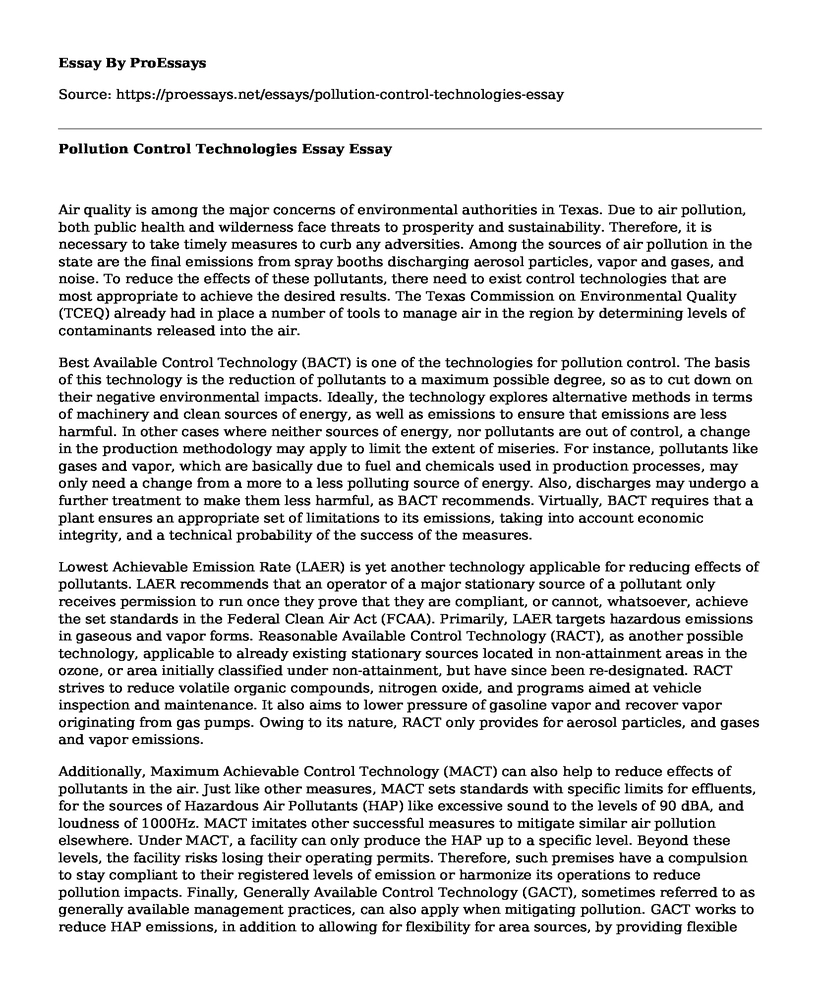Air quality is among the major concerns of environmental authorities in Texas. Due to air pollution, both public health and wilderness face threats to prosperity and sustainability. Therefore, it is necessary to take timely measures to curb any adversities. Among the sources of air pollution in the state are the final emissions from spray booths discharging aerosol particles, vapor and gases, and noise. To reduce the effects of these pollutants, there need to exist control technologies that are most appropriate to achieve the desired results. The Texas Commission on Environmental Quality (TCEQ) already had in place a number of tools to manage air in the region by determining levels of contaminants released into the air.
Best Available Control Technology (BACT) is one of the technologies for pollution control. The basis of this technology is the reduction of pollutants to a maximum possible degree, so as to cut down on their negative environmental impacts. Ideally, the technology explores alternative methods in terms of machinery and clean sources of energy, as well as emissions to ensure that emissions are less harmful. In other cases where neither sources of energy, nor pollutants are out of control, a change in the production methodology may apply to limit the extent of miseries. For instance, pollutants like gases and vapor, which are basically due to fuel and chemicals used in production processes, may only need a change from a more to a less polluting source of energy. Also, discharges may undergo a further treatment to make them less harmful, as BACT recommends. Virtually, BACT requires that a plant ensures an appropriate set of limitations to its emissions, taking into account economic integrity, and a technical probability of the success of the measures.
Lowest Achievable Emission Rate (LAER) is yet another technology applicable for reducing effects of pollutants. LAER recommends that an operator of a major stationary source of a pollutant only receives permission to run once they prove that they are compliant, or cannot, whatsoever, achieve the set standards in the Federal Clean Air Act (FCAA). Primarily, LAER targets hazardous emissions in gaseous and vapor forms. Reasonable Available Control Technology (RACT), as another possible technology, applicable to already existing stationary sources located in non-attainment areas in the ozone, or area initially classified under non-attainment, but have since been re-designated. RACT strives to reduce volatile organic compounds, nitrogen oxide, and programs aimed at vehicle inspection and maintenance. It also aims to lower pressure of gasoline vapor and recover vapor originating from gas pumps. Owing to its nature, RACT only provides for aerosol particles, and gases and vapor emissions.
Additionally, Maximum Achievable Control Technology (MACT) can also help to reduce effects of pollutants in the air. Just like other measures, MACT sets standards with specific limits for effluents, for the sources of Hazardous Air Pollutants (HAP) like excessive sound to the levels of 90 dBA, and loudness of 1000Hz. MACT imitates other successful measures to mitigate similar air pollution elsewhere. Under MACT, a facility can only produce the HAP up to a specific level. Beyond these levels, the facility risks losing their operating permits. Therefore, such premises have a compulsion to stay compliant to their registered levels of emission or harmonize its operations to reduce pollution impacts. Finally, Generally Available Control Technology (GACT), sometimes referred to as generally available management practices, can also apply when mitigating pollution. GACT works to reduce HAP emissions, in addition to allowing for flexibility for area sources, by providing flexible terms of operations aiming at reducing air pollution.
Cite this page
Pollution Control Technologies Essay. (2022, Mar 28). Retrieved from https://proessays.net/essays/pollution-control-technologies-essay
If you are the original author of this essay and no longer wish to have it published on the ProEssays website, please click below to request its removal:
- Benefits of Renewable Energy on the Environment Essay
- Case Study E-Waste Paper Example
- Essay Sample on 2010 Haiti Earthquake: A Catastrophic Natural Disaster
- Tectonic Hazards: Natural Phenomena, Risks and Challenges - Essay Sample
- Pollution Threatening Biodiversity: Global Warming & Microplastics - Essay Sample
- Essay Example on Green Theory: A Framework for International Cooperation on Environmental Issues
- Essay Example on Renewable Energy: Averting Global Warming & Collateral Damage







